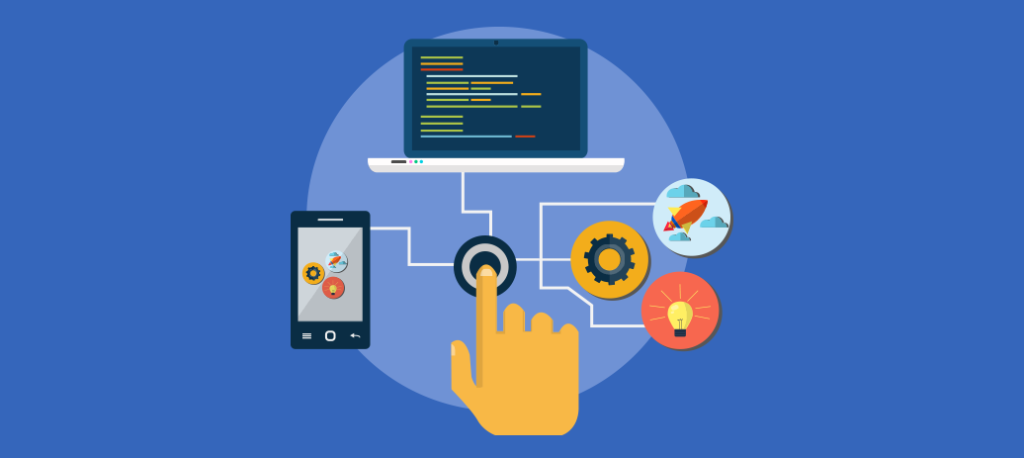A beginner’s guide to low-code app development platforms
What comes to your mind when you think of app development? A dark computer screen, long code lines, and a weary individual crossing their fingers that the compiler won’t return any errors.
For a long time, this was the case until low-code platforms like Power Apps Flow found their way to the market. While they haven’t replaced traditional coding processes, they’ve simplified app development and allowed non-technical persons to create digital solutions.
What is A Low-Code App Development Platform?
Low-code and no-code app development is the creation of applications with minimal or no codes as is the case with traditional app development practices. Usually, a low-code app development platform allows users with minimal technical knowledge to create apps using prebuilt templates and drag-and-drop features.
App development on these platforms is visual rather than verbose. Notable low-code platforms typically have two app development styles: Canvas and Model-driven. Both are simple to use but may require a bit of technical knowledge or training.
The hype around low-code app development platforms has largely been fueled by organizations seeking to create homegrown solutions for unique needs. If you’ve been toying with the idea of joining the low-code app development bandwagon, then this article is for you.
Read on as we highlight the technicalities and benefits of these development platforms.
How Do Low-Code App Development Platforms Work?
Not all low-code platforms are similar, however, they share similar working principles. They transform visual objects into background code that is needed to build an executable application.
Each action performed on a low-code app development platform is discreetly transformed into lines of code. As a result, the creator of the app does own the source code and has to pay a prescribed fee to keep the app working.
Let’s take a look at some of the common tools for low-code app development platforms.
Visual Modeling
Low-code platforms allow users to drag and drop objects onto a visual environment to create UI’s and add app features easily and fast.
Connectors and External Integration Options
This is a common feature in many low-code platforms which enables applications to communicate with third-party apps. Using APIs, your app can connect to cloud-based and on-premise endpoints.
Reusable Features
You can reuse a feature or component on other app projects on low-code platforms.
Cross-Platform Functionality
Most low-code platforms automatically compile apps for use across various platforms. This eliminates the need to repeatedly create apps for different platforms.
Multi-User and Collaboration
Several people can work on one project at the same time when working on a low-code platform.
Why Are Low-Code Platforms Getting Popular?
Reliable surveys indicate that more than 65% of applications will be developed on low-code platforms by 2025. This can be attributed to the appeal that a non-IT person can create apps without having to go through coding lessons.
Below, we’ve outlined several reasons why businesses and individuals are turning to low-code platforms for their app solutions.
Quick App Development and Deployment
An appealing aspect of low-code platforms is how quick it is to develop and deploy apps. Processes that would initially take weeks and even months can now be done in days.
Businesses and individuals can create simple home improvement apps in hours using model-driven drag-and-drop features. The benefits of this range from cost savings to increased revenues as a result of a timely reaction to a highly dynamic business environment.
Increased Efficiency
A key goal of a low-code platform is enabling businesses to develop custom applications to address unique needs. For a long time, businesses have operated on applications that partially met their needs.
With low-code platforms, businesses can now fill these gaps with homegrown solutions and in turn, optimize business processes.
Liberalization of App Development
Not to say that app development has been a preserve of a few, but learning how to code is not for everyone. Learning to create apps on low-code platforms is easy as opposed to learning programming languages.
Anyone with little technical knowledge, or who is committed to a few hours of beginner tutorial can create functional applications using low-code platforms.
Affordable App Solutions
The costs of developing apps on low-code platforms are significantly lower than that of traditional app development processes. By doing it on your own, you save on the cost of hiring a software developer.
Besides, low-code platforms such as Microsoft Powerapps have flexible payment plans that start from as low as $15 a month. You can also choose a pay-as-you-go plan that allows you to pay on a need basis.
Welcome To The World of Low-Code Platforms!
Low-code app development platforms have come as a relief to individuals and businesses that for long have struggled with inconclusive apps. You now don’t need a coding background to create apps and you don’t have to wait for months to deploy your application.
Easily create tailored apps on your favorite low-code platform and transform your business processes in a short time. Good luck.


























